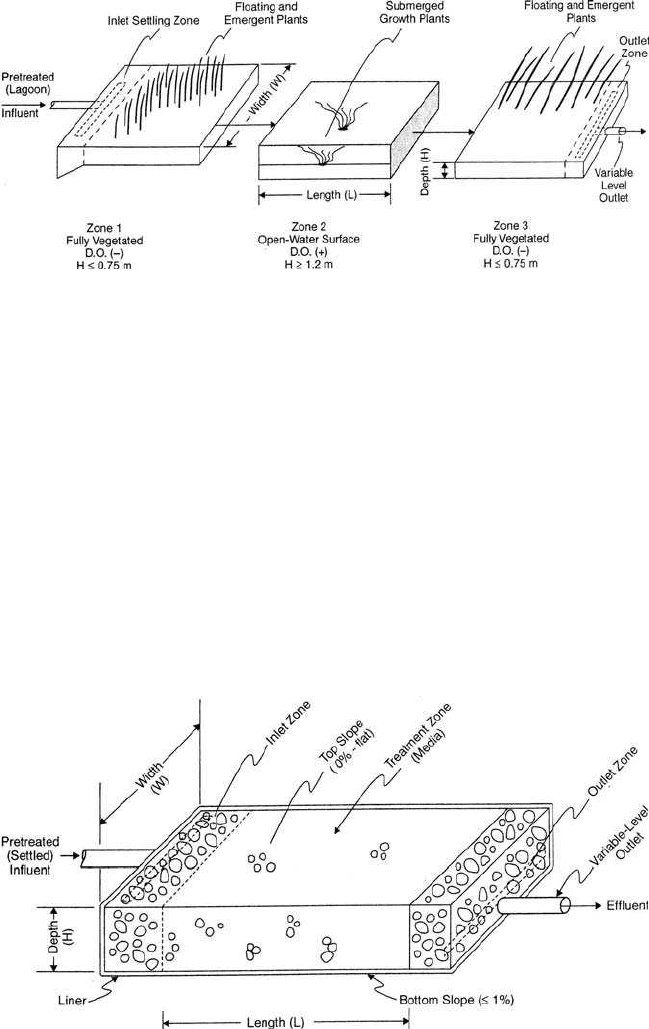Lin S.D. Water and Wastewater Calculations Manual
Подождите немного. Документ загружается.


to farmland at 10 dry ton/acre. The results of laboratory analyses for the
biosolids are shown below:
If plant nutrients added by biosolids application are not sufficient, sup-
plemental fertilizer nutrients must be provided. Routine soil fertility tests,
monitoring, and records must meet Part 503 and state agency requirements.
The field is divided into two portions for rotating cropping of corn, soybeans,
and wheat. The same biosolids have been applied to the field during the pre-
vious 2 years. The biosolids application rate and its Org-N content are as
follows:
According to the County Farm Bureau (Peoria, Illinois) for the 1999 grow-
ing season (personal communication), the crop yield and required nutrients
in lb/(acre ⭈ yr) are given below:
For the 1999 growing season, one-half of the field will be planted in wheat
and liquid biosolids will be injected to the soil in the fall (1998) after soybeans
are harvested and before the winter wheat is planted in the fall of 1998. For
the corn fields, biosolids will be surface applied and tilled in the spring of 1999
before corn is planted. There will be no other source of N for the corn field,
except for residual N from 1997 and 1998 biosolid applications.
lb/(acre ⭈ yr)
Crop Yield N P
2
O
5
K
2
O
Corn 160 150 70 140
Wheat 70 70 80 125
Soybeans 45 0 60 150
Application rate, ton/acre Org-N in biosolids, %
Crop 1997 1998 1997 1998
Corn 3.5 4.4 3.0 3.3
Wheat 5.0 0 3.1 –
Heavy metals, mg/kg
Total solids ⫽ 5.5% As ⫽ 10
Total N ⫽ 4.3% Cd ⫽ 7
NH
4
-N ⫽ 1.1% Cr ⫽ 120
NO
3
-N ⫽ 500 mg/kg Cu ⫽ 1100
Total P ⫽ 2.2% Pb ⫽ 140
Total K ⫽ 0.55% Hg ⫽ 5
pH ⫽ 7.0 Mo ⫽ 10
Ni ⫽ 120
Se ⫽ 6
Zn ⫽ 3400
Wastewater Engineering 855

The wheat field will have 23 lb of N per acre from the preceding soybean
crop; and a residual N credit for the 1997 biosolids application. No manure
will be applied and no irrigation will be made to either field.
solution:
Step 1. Compute agronomic rate for each field
(a) Convert N from percent and mg/kg to lb/ton
Total N ⫽ 2000 lb/ton ⫻ 0.043
⫽ 86 lb/ton
NH
4
-N ⫽ 2000 lb/ton ⫻ 0.011 ⫽ 22 lb/ton
NO
3
-N ⫽ 500 mg/kg ⫽ 500 ⫻
⫽ 500 ⫻ 0.002 lb/ton
⫽ 1 lb/ton
(b) Compute Org-N
Org-N ⫽ (86 ⫺ 22 ⫺ 1) lb/ton
⫽ 63 lb/ton
(c) Compute PAN for surface applied biosolids, using Eq. (6.220)
From Table 6.29
K
min
⫽ 0.20 for the first year
⫽ 0.10 for the second year
⫽ 0.05 for the third year
K
vol
⫽ 0.7 for the corn field, surface applied and tilled
⫽ 1.0 for the wheat field, injected
For the corn field
PAN ⫽ (NO
3
-N) ⫹ K
vol
(NH
4
-N) ⫹ K
min
(Org-N)
⫽ 1 lb/ton ⫹ 0.7 (22 lb/ton) ⫹ 0.2 (63 lb/ton)
⫽ 29 lb/ton
For the wheat field
PAN ⫽ 1 lb/ton ⫹ 1.0 (22 lb/ton) ⫹ 0.2 (63 lb/ton)
⫽ 36 lb/ton
(d) Compute the Org-N applied in previous years using the given data
For the corn field, Org-N applied in 1997 and 1998 was:
In 1997: Org-N ⫽ 3.5 ton/acre ⫻ 2000 lb/ton ⫻ 3%/100%
⫽ 210 lb/acre
1 lb
10
6
lb
5 500 3
1 lb
500 ton
856 Chapter 6

In 1998: Org-N ⫽ 4.4 ton/acre ⫻ 2000 lb/ton ⫻ 0.033
⫽ 290 lb/acre
For the wheat field, Org-N originally applied in 1997 was
In 1997: Org-N ⫽ 5.0 ton/acre ⫻ 2000 lb/ton ⫻ 0.031
⫽ 310 lb/acre
(e) Compute the residual N mineralized from previous years’ biosolids
applications
Construct PAN credits for the application year, 1 and 2 years later than
the growing season, as for Example 1. Take values of starting Org-N from
Step 1 d.
Org-N, lb/acre
Mineralization
Year of growing season rate K
min
Starting Mineralized Remaining
Corn field: 1997 application
0⫺1 (1997) 0.20 210 42 168
1⫺2 (1998) 0.10 168 17 151
2⫺3 (1999) 0.05 151 8 143
Corn field: 1998 application
0⫺1 (1998) 0.20 290 58 232
1⫺2 (1999) 0.10 232 23 209
2⫺3 (2000) 0.05 209 10 199
Wheat field: 1997 application
0⫺1 (1997) 0.20 310 62 248
1⫺2 (1998) 0.10 248 25 223
2⫺3 (1999) 0.05 223 11 212
The PAN credit for the 1999 growing season on the corn field due to
biosolid applications in 1997 and 1998 is 8 ⫹ 23 (in bold in the above
table) ⫽ 31 lb of N per acre, while that on the wheat field due to 1997
application is 11 lb of N per acre.
(f) Determine agronomic N rate for both fields
For the corn field
1. Total N required for corn grown (given) ⫽ 150 lb/acre
2. N provided from other sources
2a. Estimate of available N from previous applications
(from Step 1 e ) ⫽ 31 lb/acre
3. Loss of available N ⫽ 0
4. Adjusted fertilizer N required ⫽ (1) ⫺ (2a) ⫺ (3) ⫽ 119 lb/acre
5. The PAN dry ton biosolid to be applied, from
Step 1 (c) ⫽ 29 lb/ton
6. The agronomic N rate of biosolid, (4)/(5) ⫽ 4.1 dry ton/acre
7. Convert biosolids rate into wet ton/acre, 4.1/0.055 ⫽ 74.6 wet ton/acre
8. Convert biosolid rate into gal/acre ⫽ 17,900 gal/acre
⫽ (74.6 wet ton/acre ⫻ 2000 lb/ton ⫼ 8.34 lb/gal)
Wastewater Engineering 857
For the wheat field
1. Total N required for growing wheat ⫽ 70 lb/acre
2. N provided from other sources
2a. N from previous legume credit (given) ⫽ 23 lb/acre
2b. N from previous biosolids applications, from
Step 1 (e) ⫽11 lb/acre
3. Loss of available N ⫽0
4. Adjusted fertilizer N required for wheat
(1) ⫺ (2a) ⫺ (2b) ⫺ (3) ⫽ 36 lb/acre
5. PAN/dry ton biosolids to be applied, from Step l c ⫽ 36 lb/ton
6. Agronomic N rate of biosolids, (4)/(5) ⫽1 dry ton/acre
7. Convert biosolids rate into wet ton/acre ⫽18 wet ton/acre
8. Convert biosolids rate into gal/acre ⫽ 4320 gal/acre
Step 2. Determine cumulative pollution loading and maximum permitted
application rate
(a) Comparing the pollutants concentration in biosolid with the Part 503 pol-
lutant concentration limits, and comparing the concentrations of the 10
heavy metals in the biosolid with the Part 503 “CPLR limits” (Table 6.28),
the results show that all heavy metals concentrations in biosolids are less
than the limits, except for zinc; therefore, the CPLR limits must be met
for the biosolids.
(b) Compute the maximum permitted biosolids application rate for each pol-
lutant. The maximum total amount of biosolids permitted to be applied
to soil can be calculated from the CPLR limits from Table 6.30 and the
concentrations of pollutants, using Eq. (6.224).
The maximum biosolids application rate allows for
As ⫽ 37 lb/acre ÷ [0.002 (10 mg/kg)] ⫽ 1850 dry ton/acre
Cd ⫽ 35 lb/acre ÷ [0.002 (7 mg/kg)] ⫽2550 dry ton/acre
Cr will be deleted from Part 503
Cu ⫽ 1300 lb/acre ÷ [0.002 (1100 mg/kg)] ⫽ 590 dry ton/acre
Pb ⫽ 270 lb/acre ÷ [0.002 (140 mg/kg)] ⫽ 964 dry ton/acre
Hg ⫽ 15 lb/acre ÷ [0.002 (5 mg/kg)] ⫽ 1500 dry ton/acre
Mo deleted
Ni ⫽ 380 lb/acre ÷ [0.002 (120 mg/kg)] ⫽ 1583 dry ton/acre
Se ⫽ 90 lb/acre ÷ [0.002 (6 mg/kg)] ⫽ 7500 dry ton/acre
Zn ⫽ 2500 lb/acre ÷ [0.002 (3400 mg/kg)] ⫽ 367 dry ton/acre
Note: Zn is the lowest allowed application rate, and it is much higher
than the agronomic N rate. Thus heavy metal pollutants are not the limit
factor.
858 Chapter 6

(c) Compute the amount of each pollutant in the 1999 growing season
According to Part 503, the pollutant loading for each biosolid application
must be calculated and recorded to keep a cumulative summation of the total
amount of each pollution. The amount of each pollutant can be calculated, using
Eq. (6.225), from the given pollutant concentrations for corn and wheat fields.
The results are shown below.
(d) Estimate the number of years biosolids can be applied
Assume that biosolids continue to have the same quality over time, and
zinc would continue to be the limiting pollutant (see Step 2 b, 367 dry ton/acre
is the maximum biosolids application rate for zinc). For this example, it
is assumed that an average rate of 1.4 dry ton (acre ⭈ yr) would be applied
over time. The number of years biosolid could be applied before reaching
the CPLR can be computed from maximum biosolid allowed, divided by
the average annual application rate, as follows:
Number of years ⫽ 367 dry ton/acre ⫼ 1.4 dry ton/(acre ⭈ yr)
⫽ 262 years
Step 3. Compute the agronomic P rate for each field
(a) The total P
2
O
5
can be computed by Eq. (6.223). Given that anaerobic
biosolids have 2.2% total P
Total P
2
O
5
⫽ 2.2% ⫻ 20 ⫻ 2.3 lb/(ton ⭈ %)
⫽ 101 lb/dry ton
(b) The plant available P
2
O
5
is computed by Eq. (6.222)
Available P
2
O
5
⫽ 0.5 (101 lb/dry ton)
⫽ 50 lb/dry ton
(c) For the corn field
P
req
⫽ 70 lb P
2
O
5
/acre (given)
Amount applied, lb/acre
Concentration in Corn field Wheat field
Pollutant biosolids, mg/kg (1.4 ton/acre)
†
(1.0 ton/acre)
As 10 0.028
∗
0.020
Cd 7 0.020 0.014
Cr (deleted) – – –
Cu 1100 3.08 2.2
Pb 140 0.39 0.28
Hg 5 0.014 0.010
Mo (deleted) – – –
Ni 120 0.34 0.24
Se 6 0.017 0.012
Zn 2400 6.72 6.8
†
see Step 4 (the agronomic P rate for the corn field is 1.4 dry ton/acre only)
∗
lb pollutant/acre: 1.4 ton/acre ⫻ 0.002 (10 mg/kg) ⫽ 0.028 lb/acre
Wastewater Engineering 859
For the wheat field
P
req
⫽ 80 lb P
2
O
5
/acre (given)
(d) Calculate the agronomic P rate using Eq. (6.221)
For the corn field
Agronomic P rate ⫽ P
reg
⫼ (available P
2
O
5
/dry ton)
⫽ (70 lb/acre) ⫼ (50 lb/dry ton)
⫽ 1.4 dry ton/acre
For the wheat field
Agronomic P rate ⫽ 80 ÷ 50
⫽ 1.6 dry ton/acre
Step 4. Determine the application rate of biosolid on the corn field
Because the agronomic P rate for the corn field (1.4 dry ton/acre) is less than
the agronomic N rate (4.1 dry ton/acre, Step l f-6), this rate, 1.4 dry ton/acre,
is selected to be used for the 1999 growing season. A supplemental N fertil-
izer must be added to fulfill the remaining N needs for corn not supplied by
the biosolid.
Step 5. Determine the supplemental N fertilizer for the corn field
The amount of additional N needed for the corn can be computed by multi-
plying the PAN in lb/dry ton by the rate of biosolids application, then sub-
tracting this PAN in lb/acre from the adjusted fertilizer N requirement.
Referring to Step l c and Step 1 f-4, supplemental N can be determined as
Biosolids N credit ⫽ 29 lb PAN/dry ton ⫻ 1.4 dry ton/acre
⫽ 41.0 lb PAN/acre
Supplemental N ⫽ 119 lb/acre ⫺ 41 lb/acre
⫽ 78 lb/acre
Step 6. Determine the supplemental K fertilizer for the corn field
(a) Calculate the available K
2
O added by biosolids, using Eq. (6.227)
Given: % K in the biosolid ⫽ 0.55
Available K
2
O ⫽ % K in biosolids ⫻ 20 lb/dry ton · % ⫻ 1.2
⫽ 0.55 ⫻ 24 lb/dry ton
⫽ 13 lb/dry ton
(b) Compute the amount of biosolid K
2
O applied, using Eq. (6.226)
Biosolid K
2
O added ⫽ 1.4 dry ton/acre (see Step 4) ⫻ 13 lb/dry ton
⫽ 18.2 lb/acre (say 18 lb/acre)
860 Chapter 6
(c) Compute supplemental K
2
O needed
Additional K
2
O needed ⫽ required (given) ⫺ biosolids K
2
O
⫽ 140 lb/acre ⫺ 18 lb/acre
⫽ 122 lb/acre
Step 7. Determine the application rate of biosolid for the wheat field
For the wheat field, the agronomic N rate of 1.0 dry ton/acre of biosolids appli-
cation is the choice since it is less than the agronomic P rate (1.6 dry ton/acre).
Step 8. Determine the supplemental P for the wheat field, referring to
Steps 3 and 5
Biosolids P credit ⫽ 50 lb P
2
O
5
/dry ton ⫻ 1.0 dry ton/acre
⫽ 50 lb P
2
O
5
/acre
Additional P needed ⫽ (80 ⫺ 50) lb P
2
O
5
/acre
⫽ 30 lb P
2
O
5
/acre
Step 9. Determine the supplemental K for the wheat field
(a) Compute the biosolid K
2
O added
From Step 6 (a)
available K
2
O ⫽ 13 lb/dry ton (from step 6 a)
Biosolid K
2
O added ⫽ 1.0 dry ton/acre ⫻ l3 lb/dry ton
⫽ 13 lb/acre
(b) Compute additional K
2
O needed
⫽ 125 lb/acre ⫺ 13 lb/acre
⫽ 112 lb/acre
30 Wetlands
Wetlands are defined in Federal Register (40 CFR 230.3(t)) as “those
areas that are inundated or saturated by surface or groundwater at the
frequency and duration sufficient to support, and that under normal cir-
cumstances do support, a prevalence of vegetation typically adapted for
life in saturated soil conditions.”
Since the early 1950s, researches have been conducted on treatment
capacity and ecological impacts of wetlands for wastewater treatment.
The results of researches indicated that natural and man-made (con-
structed) wetlands can treat domestic wastewater and plant effluent (for
polishing) effectively to remove BOD
5
, TSS, nutrients (N and P), and
color. The wetlands treatments included for domestic, industrial, and
agricultural wastewaters.
Wastewater Engineering 861
In the early 1980s, the US EPApublished a comprehensive literature
review on the effects of wastewater treatment on wetlands (US EPA,
1983), the ecological impacts of wastewater on wetlands—an annotated
bibliography (US EPA, 1984a) and the wetland evaluation methodolo-
gies (US EPA, 1984b).
The wetland treatment of wastewater had gained acceptance, espe-
cially for small communities with strained capital and O & M costs with
available large land available. In a wetland, the aquatic system treats
wastewater by means of both physical sedimentation and bacterial
metabolism that are similar to the conventional wastewater treatment.
The first design manual on wetlands and aquatic plant systems for
municipal wastewater treatments was published by the US EPA (1988).
Later a more comprehensive manual of constructed wetlands treatment
of municipal wastewaters was published (US EPA, 2000). In its 1994
report, the US EPA was considering wetlands at CERCLA (the
Comprehensive Environmental Response, Compensation and Liability
Act, or Superfund) sites (US EPA, 1994).
There are three categories of aquatic wastewater treatment systems
(US EPA, 1988):
1. Natural wetlands
2. Aquatic plant systems
3. Constructed wetlands
30.1 Natural wetlands
Natural wetlands are referred to as marshes, swamps, bogs, and similar
areas with native vegetation. They are existing wetlands that had little
or no modification by humans. Grasses or forbs (nonwoody plants) are
generally dominant in marshes; trees and shrubs grow in swamp area;
and sedge and peat vegetations occur in various bogs. The modification
or direct use of natural wetlands for wastewater treatment is discouraged.
Natural wetlands are effective as wastewater treatment. The percent
removals of some parameters by natural wetlands are (Reed et al., 1979):
BOD
5
: 70 to 96
TSS: 60 to 90
Nitrogen: 40 to 90
Phosphorus: 19 to 98 (seasonal)
30.2 Aquatic plant systems
Aquatic plant systems are shallow ponds with floating or submerged
aquatic plants. Water hyacinth and duckweed are the most thoroughly
862 Chapter 6
studied floating plant systems. These systems are usually used for
advanced treatment of secondary effluent or in oxidation ponds for pol-
ishing purposes. The plants derive the needed carbon dioxide from the
atmosphere and use nutrients in the water. The water hyacinth has
rapid growth with an extensive root system to support media for bac-
teria. It is temperature sensitive and is rapidly killed by frost. Removal
of dead plants is cumbersome.
Duckweed occurs in natural wetlands and in lagoons (common at the
highway rest areas). It is less sensitive to cold weather. However, it has
a shallow root system, is sensitive to wind, and is easily flushed away
by high wind.
The second type of aquatic system is the submerged plant system.
Submerged plants are either rooted in the bottom sediments or sus-
pended in the water column. Typically, photosynthesis in these plants
occurs in the water column. Submerged plants are relatively easily
inhibited by high turbidity in the water. These plants tend to be shaded
by algal growths and are killed by anaerobic conditions.
30.3 Constructed wetlands
Artificial (constructed) wetlands are wetlands that have been built or
extensively modified by humans. Modification examples are filling,
draining, or altering the flow patterns or physical properties of the wet-
land. They are typically constructed with uniform depths and regular
shapes near the source of the wastewater and are often located in upland
areas where no wetlands have historically existed. Constructed wet-
lands are almost always regulated as wastewater treatment facilities
and cannot be used for compensatory mitigation. Constructed wetlands
that provide advanced treatment to wastewater that has been pre-
treated to secondary levels, and also other benefits such as wildlife habi-
tat, research laboratories, or recreational uses, are sometimes called
enhancement wetlands.
Constructed wetlands have been classified into two types (US EPA,
2000); namely, free water surface (FWS) wetlands and vegetated sub-
merged bed (VSB) wetland systems. The FWS wetlands (Fig. 6.63) also
known as surface flow wetlands, closely resembling natural wetlands in
appearance because they contain aquatic plants that are rooted in a soil
layer on the bottom of the wetland with water flowing through the
leaves and stems of plants.
Vegetated submerged bed systems (Fig. 6.64), also known as subsur-
face flow wetlands) do not resemble natural wetlands because they have
no standing water. They contain a bed of media (such as crushed rock,
small stones, gravel, sand, or soil) that has been planted with aquatic
plants. When properly designed and operated, wastewater stays beneath
Wastewater Engineering 863

the surface of the media, flows in contact with the roots and rhizomes
of the plants, and is not visible or available to wildlife.
Unlike natural wetlands, constructed wetlands are designed and oper-
ated to meet certain performance standards. The constructed wetland,
once designed and operated, requires regular monitoring to ensure
proper operation and routine management to maintain optimum per-
formance. On the basis of monitoring results, the system may need
minor modifications.
Environmental and health considerations. Since wetland systems affect
aesthetic, ecological, and recreational impacts in the area, during the
planning of constructed wetland, some technical, environmental, and
864 Chapter 6
Figure 6.63 Elements of a free water surface (FWS) constructed wetland (source:
US EPA 2001).
Figure 6.64 Elements of a vegetated submerged bed (VSB) system (source: US EPA 2001).
